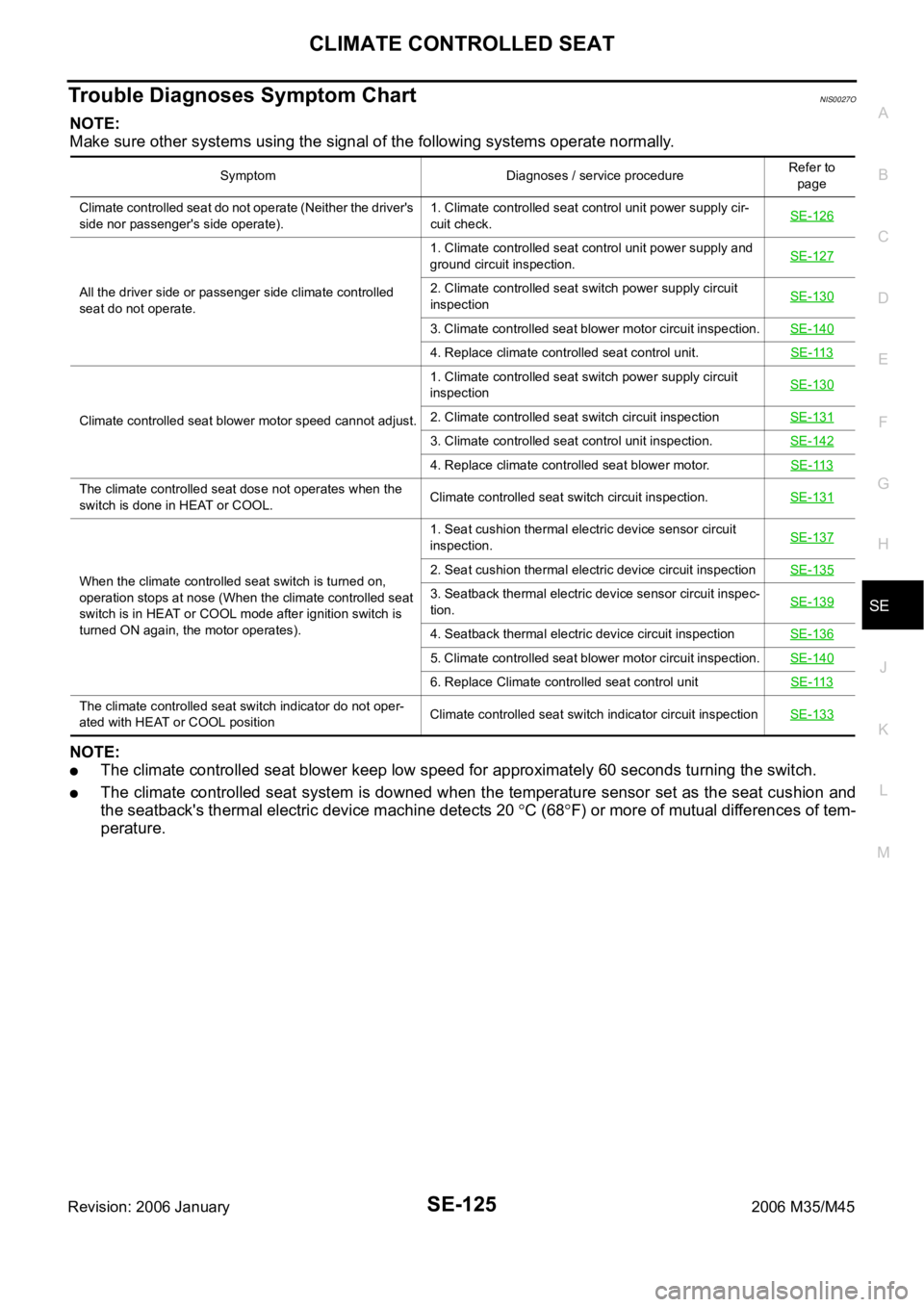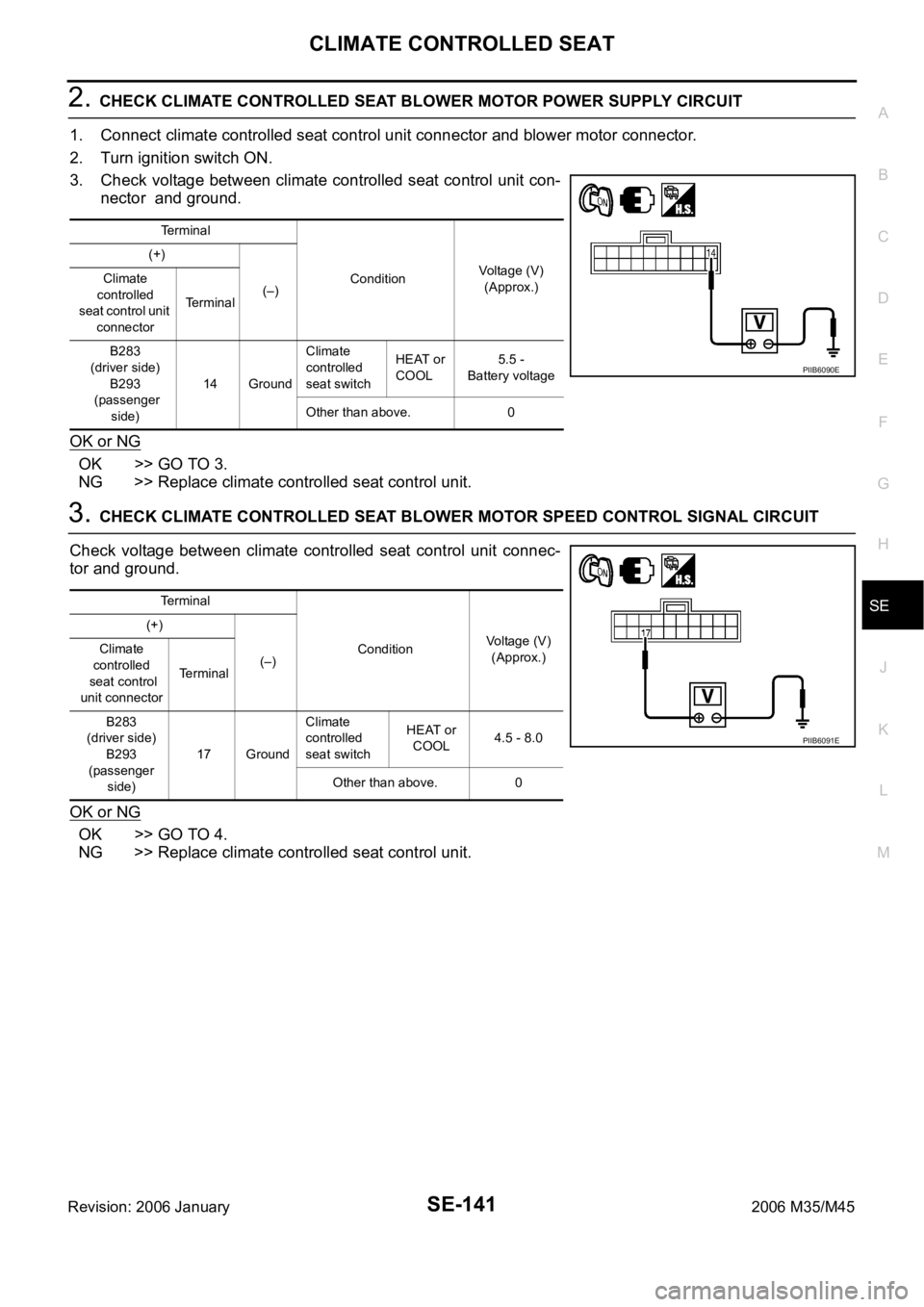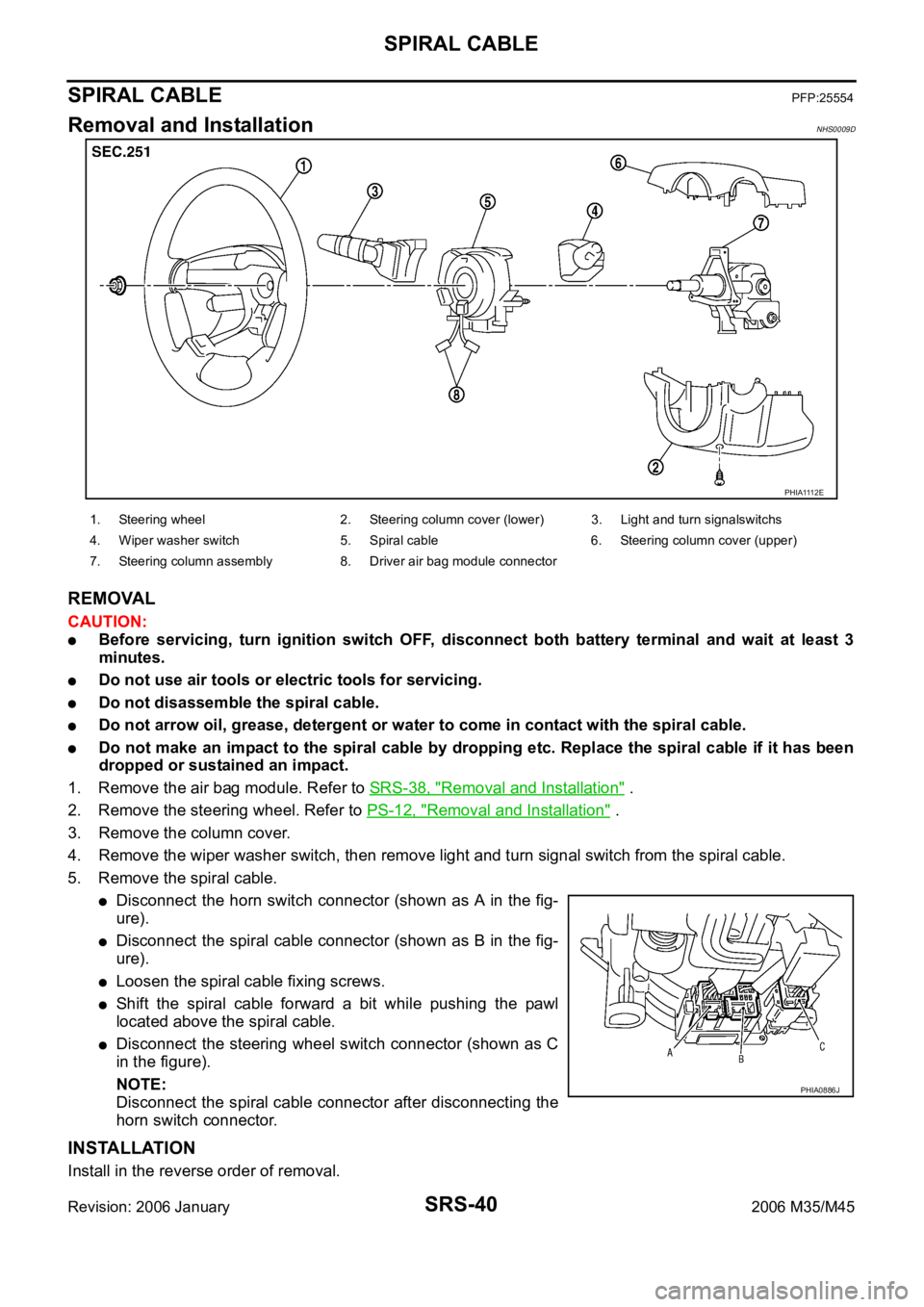2006 INFINITI M35 turn signal
[x] Cancel search: turn signalPage 5306 of 5621

CLIMATE CONTROLLED SEAT
SE-125
C
D
E
F
G
H
J
K
L
MA
B
SE
Revision: 2006 January2006 M35/M45
Trouble Diagnoses Symptom ChartNIS0027O
NOTE:
Make sure other systems using the signal of the following systems operate normally.
NOTE:
The climate controlled seat blower keep low speed for approximately 60 seconds turning the switch.
The climate controlled seat system is downed when the temperature sensor set as the seat cushion and
the seatback's thermal electric device machine detects 20
C (68F) or more of mutual differences of tem-
perature.
Symptom Diagnoses / service procedureRefer to
page
Climate controlled seat do not operate (Neither the driver's
side nor passenger's side operate).1. Climate controlled seat control unit power supply cir-
cuit check.SE-126
All the driver side or passenger side climate controlled
seat do not operate.1. Climate controlled seat control unit power supply and
ground circuit inspection.SE-1272. Climate controlled seat switch power supply circuit
inspectionSE-130
3. Climate controlled seat blower motor circuit inspection.SE-140
4. Replace climate controlled seat control unit.SE-113
Climate controlled seat blower motor speed cannot adjust.1. Climate controlled seat switch power supply circuit
inspectionSE-1302. Climate controlled seat switch circuit inspectionSE-131
3. Climate controlled seat control unit inspection.SE-142
4. Replace climate controlled seat blower motor.SE-113
The climate controlled seat dose not operates when the
switch is done in HEAT or COOL.Climate controlled seat switch circuit inspection.SE-131
When the climate controlled seat switch is turned on,
operation stops at nose (When the climate controlled seat
switch is in HEAT or COOL mode after ignition switch is
turned ON again, the motor operates).1. Seat cushion thermal electric device sensor circuit
inspection.SE-1372. Seat cushion thermal electric device circuit inspectionSE-135
3. Seatback thermal electric device sensor circuit inspec-
tion.SE-139
4. Seatback thermal electric device circuit inspectionSE-136
5. Climate controlled seat blower motor circuit inspection.SE-140
6. Replace Climate controlled seat control unitSE-113
The climate controlled seat switch indicator do not oper-
ated with HEAT or COOL positionClimate controlled seat switch indicator circuit inspectionSE-133
Page 5322 of 5621

CLIMATE CONTROLLED SEAT
SE-141
C
D
E
F
G
H
J
K
L
MA
B
SE
Revision: 2006 January2006 M35/M45
2. CHECK CLIMATE CONTROLLED SEAT BLOWER MOTOR POWER SUPPLY CIRCUIT
1. Connect climate controlled seat control unit connector and blower motor connector.
2. Turn ignition switch ON.
3. Check voltage between climate controlled seat control unit con-
nector and ground.
OK or NG
OK >> GO TO 3.
NG >> Replace climate controlled seat control unit.
3. CHECK CLIMATE CONTROLLED SEAT BLOWER MOTOR SPEED CONTROL SIGNAL CIRCUIT
Check voltage between climate controlled seat control unit connec-
tor and ground.
OK or NG
OK >> GO TO 4.
NG >> Replace climate controlled seat control unit.
Terminal
ConditionVoltage (V)
(Approx.) (+)
(–) Climate
controlled
seat control unit
connectorTerminal
B283
(driver side)
B293
(passenger
side)14 GroundClimate
controlled
seat switchHEAT or
COOL5.5 -
Battery voltage
Other than above. 0
PIIB6090E
Terminal
ConditionVoltage (V)
(Approx.) (+)
(–) Climate
controlled
seat control
unit connectorTerminal
B283
(driver side)
B293
(passenger
side)17 GroundClimate
controlled
seat switchHEAT or
COOL4.5 - 8.0
Other than above. 0
PIIB6091E
Page 5378 of 5621
![INFINITI M35 2006 Factory Service Manual TROUBLE DIAGNOSIS
SRS-17
C
D
E
F
G
I
J
K
L
MA
B
SRS
Revision: 2006 January2006 M35/M45
CONSULT-II FunctionNHS00094
DIAGNOSIS MODE FOR CONSULT-II
“SELF-DIAG [CURRENT]”
A current self-diagnosis r INFINITI M35 2006 Factory Service Manual TROUBLE DIAGNOSIS
SRS-17
C
D
E
F
G
I
J
K
L
MA
B
SRS
Revision: 2006 January2006 M35/M45
CONSULT-II FunctionNHS00094
DIAGNOSIS MODE FOR CONSULT-II
“SELF-DIAG [CURRENT]”
A current self-diagnosis r](/manual-img/42/57023/w960_57023-5377.png)
TROUBLE DIAGNOSIS
SRS-17
C
D
E
F
G
I
J
K
L
MA
B
SRS
Revision: 2006 January2006 M35/M45
CONSULT-II FunctionNHS00094
DIAGNOSIS MODE FOR CONSULT-II
“SELF-DIAG [CURRENT]”
A current self-diagnosis results (also indicated by the number of warning lamp flashes in the Diagnosis
mode) is displayed on the CONSULT-II screen in real time. This refers to a malfunctioning part requiring
repairs.
“SELF-DIAG [PAST]”
Diagnosis results previously stored in the memory are displayed on the CONSULT-II screen. The stored
results are not erased until memory erasing is executed.
“TROUBLE DIAG RECORD”
With TROUBLE DIAG RECORD, diagnosis results previously erased by a reset operation can be dis-
played on the CONSULT-II screen.
“ECU DISCRIMINATED NO.”
The diagnosis sensor unit for each vehicle model is assigned
with its own, individual classification number. This number will
be displayed on the CONSULT-II screen, as shown. When
replacing the diagnosis sensor unit, refer to the part number for
the compatibility. After installation, replacement with a correct
unit can be checked by confirming this classification number on
the CONSULT-II screen.
After repair, make sure the discriminated number of diagnosis
sensor unit installed to vehicle are same. Refer to SRS-48,
"ECU DISCRIMINATED NO." .
PASSENGER AIR BAG
The STATUS (Readiness) of the front passenger air bag module is displayed.The STATUS displayed
(ON/OFF) depends on the signals supplied to the occupant classification system control module and
air bag diagnosis sensor unit. Refer to SRS-7, "
Occupant Classification System (OCS)" for more infoma-
tion.
HOW TO CHANGE SELF-DIAGNOSIS MODE WITH CONSULT-II
From User Mode to Diagnosis Mode
After selecting “AIR BAG” on the “SELECT SYSTEM” screen, User mode automatically changes to Diagnosis
mode.
From Diagnosis Mode to User Mode
To return to User mode from Diagnosis mode, touch “BACK” key of CONSULT-II until “SELECT SYSTEM”
appears, then diagnosis mode automatically changes to User mode.
PHIA0218E
SRS803
SRS804
Page 5401 of 5621

SRS-40
SPIRAL CABLE
Revision: 2006 January2006 M35/M45
SPIRAL CABLEPFP:25554
Removal and InstallationNHS0009D
REMOVAL
CAUTION:
Before servicing, turn ignition switch OFF, disconnect both battery terminal and wait at least 3
minutes.
Do not use air tools or electric tools for servicing.
Do not disassemble the spiral cable.
Do not arrow oil, grease, detergent or water to come in contact with the spiral cable.
Do not make an impact to the spiral cable by dropping etc. Replace the spiral cable if it has been
dropped or sustained an impact.
1. Remove the air bag module. Refer to SRS-38, "
Removal and Installation" .
2. Remove the steering wheel. Refer to PS-12, "
Removal and Installation" .
3. Remove the column cover.
4. Remove the wiper washer switch, then remove light and turn signal switch from the spiral cable.
5. Remove the spiral cable.
Disconnect the horn switch connector (shown as A in the fig-
ure).
Disconnect the spiral cable connector (shown as B in the fig-
ure).
Loosen the spiral cable fixing screws.
Shift the spiral cable forward a bit while pushing the pawl
located above the spiral cable.
Disconnect the steering wheel switch connector (shown as C
in the figure).
NOTE:
Disconnect the spiral cable connector after disconnecting the
horn switch connector.
INSTALLATION
Install in the reverse order of removal.
PHIA1112E
1. Steering wheel 2. Steering column cover (lower) 3. Light and turn signalswitchs
4. Wiper washer switch 5. Spiral cable 6. Steering column cover (upper)
7. Steering column assembly 8. Driver air bag module connector
PHIA0886J
Page 5419 of 5621
![INFINITI M35 2006 Factory Service Manual STC-4
[EPS]
SYSTEM DESCRIPTION
Revision: 2006 January2006 M35/M45
Fail-Safe FunctionNGS000DW
When the fail-safe function operate, it controls power steering sole-
noid valve by the engine spe INFINITI M35 2006 Factory Service Manual STC-4
[EPS]
SYSTEM DESCRIPTION
Revision: 2006 January2006 M35/M45
Fail-Safe FunctionNGS000DW
When the fail-safe function operate, it controls power steering sole-
noid valve by the engine spe](/manual-img/42/57023/w960_57023-5418.png)
STC-4
[EPS]
SYSTEM DESCRIPTION
Revision: 2006 January2006 M35/M45
Fail-Safe FunctionNGS000DW
When the fail-safe function operate, it controls power steering sole-
noid valve by the engine speed as shown in the figure and maintains
the steering force.
FAIL-SAFE INPUT/CANCEL CONDITIONS
CAUTION:
Fail-safe function is activated when the engine runs at 1,500 rpm or higher for 10 seconds with the vehicle stopped. This is
normal and the fail-safe function is automatically deactivated when a vehicle speed signal of 2 km/h (1.2 MPH) or higher is
input or the ignition switch is turned OFF.
SGIA0411E
Input conditions Cancel conditions
When vehicle runs at an engine speed of 1,500 rpm or higher and no vehicle speed signal
is received for 10 seconds.
A vehicle speed of 2 km/h (1.2 MPH) or
more is input.
Turn the ignition switch ON after turn-
ing it OFF. The continuous vehicle speed signal 30 km/h (19 MPH) or more suddenly drops to less
than 2 km/h (1.2 MPH) within 1.4 seconds.
Page 5425 of 5621
![INFINITI M35 2006 Factory Service Manual STC-10
[EPS]
TROUBLE DIAGNOSIS
Revision: 2006 January2006 M35/M45
3. CHECK POWER STEERING CONTROL UNIT POWER SUPPLY CIRCUIT
Turn ignition switch ON, and then check voltage between power
steer INFINITI M35 2006 Factory Service Manual STC-10
[EPS]
TROUBLE DIAGNOSIS
Revision: 2006 January2006 M35/M45
3. CHECK POWER STEERING CONTROL UNIT POWER SUPPLY CIRCUIT
Turn ignition switch ON, and then check voltage between power
steer](/manual-img/42/57023/w960_57023-5424.png)
STC-10
[EPS]
TROUBLE DIAGNOSIS
Revision: 2006 January2006 M35/M45
3. CHECK POWER STEERING CONTROL UNIT POWER SUPPLY CIRCUIT
Turn ignition switch ON, and then check voltage between power
steering control unit harness connector M8 and ground.
OK or NG
OK >> Power supply and ground circuit are normal.
NG >> Power supply circuit open or shorted. Repair or replace
any inoperative parts.
Symptom: The Steering Force Does Not Change Smoothly According to the
Vehicle Speed
NGS000E4
Heavy steering force with the static steering/light steering force during high-speed driving
1. POWER STEERING SOLENOID VALVE SIGNAL INSPECTION 1
1. Start engine.
2. Change the vehicle speed from 0 to 100 km/h (0 to 62 MPH)
slowly, and then check voltage between power steering control
unit harness connector M8 and ground.
OK or NG
OK >> GO TO 2.
NG >> GO TO 7.
2. POWER STEERING SOLENOID VALVE SIGNAL INSPECTION 2
1. Activate fail-safe function by running the engine speed at 1,500 rpm or higher for 10 seconds with the
vehicle stopped.
2. Change the engine speed to the idling, to approximately 1,600
rpm, and to approximately 3,000 rpm slowly, and then check
voltage between power steering control unit harness connector
M8 and ground.
OK or NG
OK >> GO TO 3.
NG >> GO TO 8.
3. CHECK POWER STEERING SOLENOID VALVE CONNECTOR
Turn ignition switch OFF, disconnect power steering solenoid valve harness connector, and check terminal for
deformation, disconnection, looseness, etc.
OK or NG
OK >> GO TO 4.
NG >> Harness or connector open or shorted. Repair or replace any inoperative parts. Terminal 1 – ground : Battery voltage (Approx. 12 V)
SGIA1232E
Terminal 7 – ground : The voltage has changed from
approximately 4.4 - 6.6 V to
approximately 2.4 - 3.6 V
SGIA1233E
Terminal 7 – ground : The voltage has changed from
approximately 5.5 V to approxi-
mately 2.1 V step-by-step.
SGIA1233E
Page 5430 of 5621
![INFINITI M35 2006 Factory Service Manual REAR ACTIVE STEER
STC-15
[RAS]
C
D
E
F
H
I
J
K
L
MA
B
STC
Revision: 2006 January2006 M35/M45
4. Supply 6 V voltage by connecting the four 1.5 V batteries in a
series. Connect them to the RAS motor con INFINITI M35 2006 Factory Service Manual REAR ACTIVE STEER
STC-15
[RAS]
C
D
E
F
H
I
J
K
L
MA
B
STC
Revision: 2006 January2006 M35/M45
4. Supply 6 V voltage by connecting the four 1.5 V batteries in a
series. Connect them to the RAS motor con](/manual-img/42/57023/w960_57023-5429.png)
REAR ACTIVE STEER
STC-15
[RAS]
C
D
E
F
H
I
J
K
L
MA
B
STC
Revision: 2006 January2006 M35/M45
4. Supply 6 V voltage by connecting the four 1.5 V batteries in a
series. Connect them to the RAS motor connector (motor side),
and then operate the motor and adjust the rack in the neutral
position (A).
CAUTION:
Do not supply 12 V voltage (battery, etc) to the RAS motor.
NOTE:
For right stroke, connect positive probe to the RAS motor con-
nector terminal 1. For left stroke, connect it to the terminal 2.
5. Install rear wheel steering angle sensor with O-ring to the RAS
actuator assembly. Temporarily tighten the mounting bolts in the specified torque that the sensor can be
moved by hand.
6. Turn and adjust the rear wheel steering angle sensor so as to make each sensor signal of “DATA MONI-
TOR” mode to the following standard with CONSULT-II.
CAUTION:
During DATA MONITOR mode, “MONITORING ERROR” is displayed. But there is not malfunction
in this procedure.
7. Tighten rear wheel steering angle sensor mounting bolts.
8. Perform “ERASE” with CONSULT-II, and then erase the error memory of rear wheel steering angle sen-
sor. Refer to STC-29, "
How to Erase Self-Diagnostic Results" .
9. Perform CONSULT-II “SELF-DIAG RESULTS” again, and then make sure that there is no malfunction.
Refer to STC-28, "
SELF-DIAG RESULT MODE" . Full stroke (B) : 6.8 - 7.2 mm (0.268 - 0.283 in)
STEERING ANG () L - 0, R - 0, N - 0
RR ST ANG-MAI (V) Approx. 2.4
RR ST ANG-SUB (V) Approx. 2.4
RR ST ANG-VOL (V) Approx. 5.0
SGIA1240E
Page 5431 of 5621
![INFINITI M35 2006 Factory Service Manual STC-16
[RAS]
SYSTEM DESCRIPTION
Revision: 2006 January2006 M35/M45
SYSTEM DESCRIPTIONPFP:00000
ComponentsNGS000E8
RAS (Rear Active Steer) FunctionNGS000E9
A. RAS control unit B. Model following contro INFINITI M35 2006 Factory Service Manual STC-16
[RAS]
SYSTEM DESCRIPTION
Revision: 2006 January2006 M35/M45
SYSTEM DESCRIPTIONPFP:00000
ComponentsNGS000E8
RAS (Rear Active Steer) FunctionNGS000E9
A. RAS control unit B. Model following contro](/manual-img/42/57023/w960_57023-5430.png)
STC-16
[RAS]
SYSTEM DESCRIPTION
Revision: 2006 January2006 M35/M45
SYSTEM DESCRIPTIONPFP:00000
ComponentsNGS000E8
RAS (Rear Active Steer) FunctionNGS000E9
A. RAS control unit B. Model following control C. Target vehicle dynamics model
D. Rear wheel steering angle com-
mand value operationE. Rear wheel steering angle servo F. Vehicle speed signal (CAN)
G. Steering angle signal (CAN) H. Vehicle speed sensor I. Steering angle sensor
J. RAS actuator assembly
SGIA1241E
Part name Function
RAS control unit
Calculate the vehicle speed signal from CAN communication and the signals from steering
angle sensor and rear wheel steering angle sensor by a computer, and then control the rear
wheel steering angle.
Fail-safe function is activated when the electrical system is malfunctioning. The output signal
to the actuator is turned OFF during this mode. At that time, the RAS warning lamp illumi-
nates and indicates the system is malfunctioning.
It performs the communication control function with other control units via CAN communica-
tion.
This enables system diagnosis with CONSULT-II.
RAS actuatorThe efficiency of the rear wheel steer improves by locating the electric motor actuator into the
lower link of rear suspension.
Steering angle sensor
Measure the steering angle and send it to RAS control unit via CAN communication.
It is shared with the steering angle sensor for VDC.
Rear wheel steering angle sensor
It sends the rear wheel steering angle status to RAS control unit. The accuracy of rear wheel
steer improves by comparing the vehicle speed signal from CAN communication with the
rear wheel steering angle target value calculated from the wheel angle sensor signal, and it
controls them.
There are 2 types of rear wheel steering angle sensors (main/sub). If one of them is malfunc-
tioning, the other operates the fail-safe mode and stops the control.
RAS warning lamp
It turns on when the fail-safe function is operated and indicates that a RAS control malfunc-
tion has occurred.
It turns on when ignition switch turns on and turns off after the engine is started.
It indicates the suspect system by blinking when performing the self-diagnosis (without CON-
SULT-II).